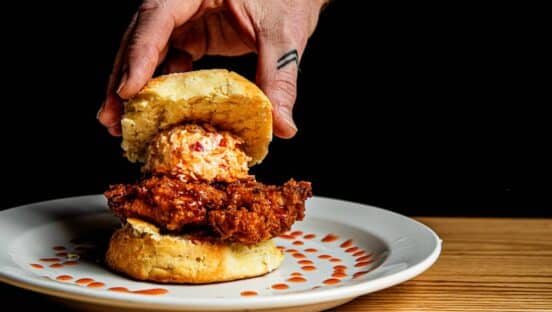For a brand that started just six years ago, Hattie B’s Hot Chicken has emerged as an icon in Nashville—a status that is quickly spreading throughout the South. With six locations to its name and more in the pipeline—including a Las Vegas outpost—father-son team Nick Bishop Sr. and Jr. are ready for whatever opportunities come their way.
Hattie B’s didn’t invent hot chicken—that’s been a Nashville specialty at restaurants like Prince’s Hot Chicken Shack for nearly a century—but the brand did concoct its own recipe and has ultimately helped serve the dish to the masses.
After 30 years in the restaurant industry working in different capacities with Morrison’s Restaurants Inc.—the owner of Ruby Tuesday for a time and parent company of Morrison’s Cafeteria—Bishop Sr. opened his own cafeteria-style concept in Franklin, Tennessee. In 2007, the single-unit, 40-seat Bishop’s Meat & Three began serving up Southern-style plates with hearty meats. Once his son joined the family business, Bishop started thinking about his next venture. “I wanted to test the waters with something else,” he says.
Hot chicken was that something else. The Bishops started working with their own spice blends to develop a hot chicken recipe for the line at Bishop’s Meat & Three. The chicken quickly dominated sales, reaching 35 percent in just a few short months. All the while, Bishop was perfecting the recipe and soliciting feedback from patrons on the mild and hot versions.
Hattie B’s Hot Chicken
FOUNDERS: Nick Bishop Sr. and Nick Bishop Jr.
HEADQUARTERS: Nashville, Tennessee
YEAR STARTED: 2012
ANNUAL SALES: Unavailable
TOTAL UNITS: 7
FRANCHISED UNITS: 0
“They would say, ‘You know, it’s really good; it’s got flavor to the bone, but it’s awfully hot,’” Bishop says. “We evaluated those comments and started thinking about how we could appeal to a broad spectrum of customers with different levels of heat.”
In 2012, the Bishops debuted their one-protein, six-heat-level menu with playful names like Damn Hot and Shut the Cluck Up in a 1,400-square-foot location in midtown Nashville. The menu is straightforward; guests choose their chicken cut and size (or tenders and wings) plus sides. But that simplicity resonated, and the community quickly rallied around the fast casual.
From there, focusing on hot chicken, Southern sides, craft beer, and a fun, family-friendly atmosphere, Hattie B’s continued to draw crowds. So much so that it became clear that future locations would require double the space. Bishop says the ideal footprint lies between 3,200 and 3,500 square feet.
Every location since the second shop on Charlotte Avenue in Nashville has been roughly that size, with a signature color palette of hot-chicken red and contrasting black and white throughout the space. Still, the buildings are anything but cookie-cutter. “We stay away from new retail and strip centers. It’s just not us,” Bishop says. “For us to commit to a Hattie B’s, we’ve really got to have a great gut feeling about what we’re doing and where we’re going.”
Hattie B’s looks for properties that have history behind them and can be repurposed, like the new Atlanta location that used to be a Phillips 66 gas station. From there, the team works through the logistics of each layout for the kitchen and what is needed to operate, then the rest of the layout falls into place. Bishop says a talented architect out of Birmingham, Alabama, has been instrumental in designing the dining room layout and flow.
All locations except for one are freestanding, and they have a combination of indoor and outdoor seating, the latter of which is winterized. “As far as the look and feel of the Hattie B’s, our brand is becoming known around the country, and it’s really no different than when they see our signage or our chicken. We try to replicate those features and parts of our brand in every store,” Bishop says. “Someone eating in Memphis, when looking around, will know they’re in a Hattie B’s. Our brand components bring these things together.”
Over the year, Hattie B’s has opened three locations in the South. “Will every year be that way? I hope not,” Bishop says. Finding the right location is hard work, but not as difficult as maintaining leadership and a positive work culture. Bishop is determined that the company should stay true to its core values.
As of now, all stores are company owned, but if the family decides to franchise in the future, Bishop assures that whomever they deal with moving forward will have the same interests. “It’s about having a culture that we can be proud of so that people have a safe place to come to work, they like each other, and they’re taken care of. That’s much more important to me than a guy who wants to buy a licensing agreement,” he says. Hattie B’s culture is maintained, he says, through the leadership team’s efforts every day and in training and development for employees.
The brand is taking it one restaurant at a time, but that steady pace does not mean Hattie B’s is turning a blind eye to untapped markets and new opportunities.
“[Looking ahead,] it is truly doing the best we can with every opening and opportunity we get, making great decisions, getting better at what we do, and then moving on to the next restaurant,” Bishop says. “We’re going to be smart and thoughtful in our approach as we grow, and I think the sky’s the limit.”









